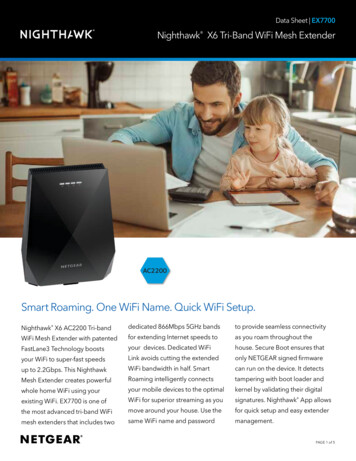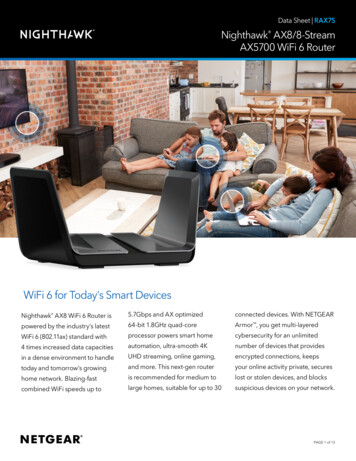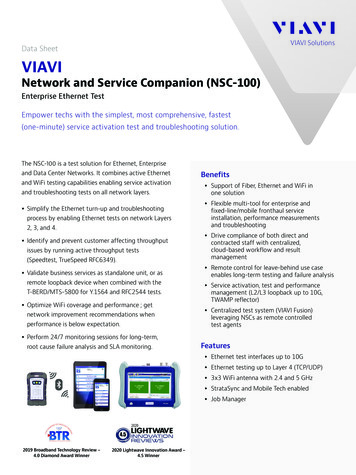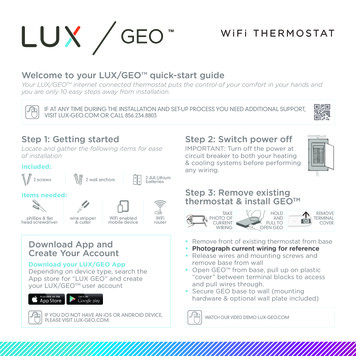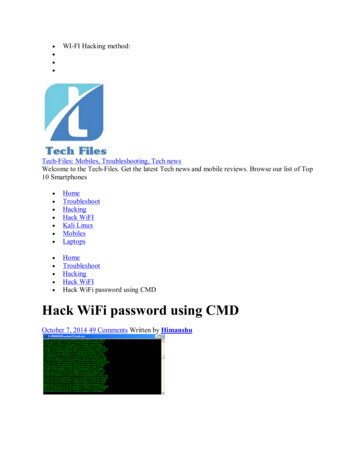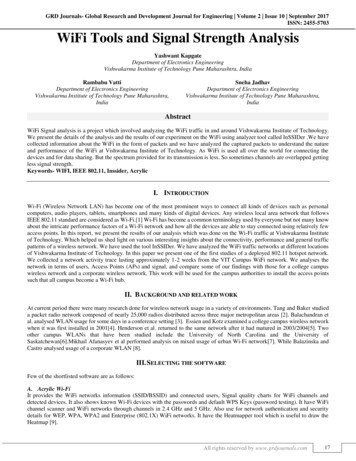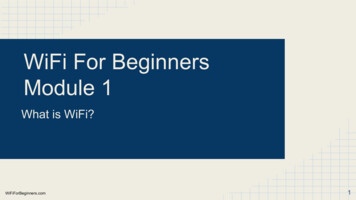
Transcription
WiFi For BeginnersModule 1What is WiFi?WiFiForBeginners.com1
IntroductionHello, my name’s Nigel Bowden. Welcome to the WiFi for beginners podcast. This isa series of podcasts discussing the fundamentals of wireless LAN networking.In each episode, we’ll take a look at a different aspect of WiFi to build yourunderstanding and knowledge of wireless LAN networks.Each episode is be accompanied by a set of slides describing the topics covered inthat episode. Although you don’t need to review these slides whilst listening to thepodcast, they will be useful for reviewing the material we discuss and may providesome visual aids to more fully understand some of the concepts and equipmentdescribed.All recordings and supporting material can be found at WiFiForBeginners.comWiFiForBeginners.com2
Who Am I? Nigel BowdenUK BasedIT & Telecoms Industry for 30 yearsSpecializing in Wireless LANs for 5 yearsIndustry certifications: CWNP: Certified Wireless Network Expert (CWNE #135) Cisco CCNP R&S Cisco CCNP Wireless Miscellaneous other vendor specific certs Roles: Design, Consultancy & Deployment of WLANs (mainly Cisco) Prolific social media participant: @WiFiNigel (Twitter) WiFiNigel.blogspot.com (Blog)WiFiForBeginners.com3
Aims of Podcast Series Present the fundamentals of WiFi in a series of audio presentations Hopefully in an easy-to-understand format Useful to those on a daily commute, driving, running etc.Who is it aimed at? Most likely IT professionals, students, people interested in careermoveAssumed knowledge: Fundamentals of the 7 layer OSI model Ethernet Switching and routing IP addressing Local Area Networks (LAN)WiFi in commercial/professional environment - not homeWiFiForBeginners.com4
Series Topics 01 - What is WiFi?02 - RF Basics03 - Access Points04 - More RF05 - WiFi Clients06 - Standards Bodies07 - Wireless Control & Management08 - Security09 - WiFi Network Design10 - Becoming a WiFI GuruWiFiForBeginners.com5
In This Episode What is a WiFi network?What is a wireless client?What is a wireless access point?What is a wireless controller?WiFi SecurityWireless LAN StandardsWiFiForBeginners.com6
What is a "WiFi?" Network? "WiFi" is brand name of the WiFi Alliance, used Industry organisation responsible for interoperability testing ofequipmentA “WiFi” network is a wireless network which is more correctly: "WirelessLAN" (WLAN) Wireless Local Area NetworkWiFi Network & Wireless LAN terms for the same type of wireless networkWireless LAN (WiFi network): a wireless network that uses equipment thatconforms to the IEEE 802.11 standardDoesn’t include similar wireless technologies such as Bluetooth or ZigbeeLike a “LAN”, a “WLAN” generally constrained to a floor/building/campus Some “edge” cases e.g. point to point links between buildingsWiFiForBeginners.com7
Reference ModelStandard Wired Network:WiFiForBeginners.com8
Reference ModelExtended edge (switch):WiFiForBeginners.com9
Reference ModelExtended edge (access point):WiFiForBeginners.com10
What is a "WiFi?" Network? WLANS deployed in many environments including: Education (schools & universities) Healthcare (hospitals) Manufacturing Logistics Enterprise Hospitality (hotel/conference) Stadium Home Small/Medium businessEach has own requirements & challengesWiFiForBeginners.com11
What is a "WiFi?" Network? Main wireless infrastructure components: Wireless Access Points (AP) Wireless Clients (e.g. laptops, tablets, smartphones) Wireless LAN controller (Data) Cable InfrastructureAlthough a WLAN is a “wireless” network, still requires a wired network toconnect wireless infrastructure together and provide access to servicesA WLAN is generally overlaid on a (wired) LANAPs installed at the edge layer of network: extension of edge switchesThe job of the wireless network is to convert wireless client data into aformat to be placed back on to wired network instead of wired edge switch port, we have a wireless edge connectionWiFiForBeginners.com12
What is a wireless client? Wireless “Client” a user device that has WiFi capability examples: tablets, smartphones, laptops, barcode scanners, medicalequipment, security systems may also be referred to as a “Station” in 802.11 standard & textbooksWireless “clients” connect over a wireless connection to an “access point”using radio signals which carry user data instead of connecting a device in to the edge of a network by pluggingour client in to a switch, a wireless connection ‘plugs’ device in tonetwork For wired devices (clients), use an 802.3 layer 2 connection For wireless device (clients), use an 802.11 layer 2 connectionWiFiForBeginners.com13
What is a wireless client? Clients all have two major RF components: radio - transmit & receive signals antenna - may be multipleCapabilities of clients vary considerably: How much power they have to transmit a signal battery powered? power levels, capacity How well they can “hear” signals from the wireless network size, type and number of antennas Which IEEE 802.11 standard amendments they support 802.11g, 802.11n, 802.11acWiFiForBeginners.com14
What is an access point?WiFiForBeginners.com15
What is an access point? AP can be thought of in two halves: wireless : radio & antenna wired: Ethernet portPrimary job is to convert radio frequency signals carrying data to/fromclients on wireless side into data to flow through its Ethernet port on thewired sideActs as a “bridge” between clients data (over RF link) and the Ethernetnetwork converts between 802.11 & 802.3 framesEthernet network is edge layer of wired network access points typically share same area of the wired networkWiFiForBeginners.com16
What is an access point? Often more than one radio as AP may support more than one band 2.4GHz 5GHzMultiple antennas - generally 2 to 4 internal externalGenerally suspended from ceilings or walls throughout facilityCoverage provided by each access point limited, so generally have theminstalled throughout a facilityWiFiForBeginners.com17
What is a wireless controller?WiFiForBeginners.com18
What is a wireless controller? Requirement for wireless controller (WLC) dependant upon network size vendor architectureProvides central management & coordination point for wireless network Large number of APs difficult to configure and manage individually Some functions of a WLAN require central coordination AP channels being used AP power settings Roaming Security Monitoring of APs centralizedWiFiForBeginners.com19
What is a wireless controller? Controller function may be: a hardware or VM on-site in the “cloud” shared function across access points cooperative controlIn all but the simplest networks, controller function is required in some formWiFiForBeginners.com20
What is a "WiFi?" Network?WiFiForBeginners.com21
WiFi Security Due to ubiquitous nature of the coverage of WiFi networks, security is aprimary concern Wireless LAN network often stretch beyond perimeter of a building orfloor where a network is deployed Provides opportunities for eavesdropping equivalent of having span port on Ethernet switch to capturetraffic “Over the air” nature of WLANs also provides opportunities forinterception of traffic man in the middle attacks by setting up dummy APs using sameSSID as your networkWiFiForBeginners.com22
WiFi Security Need to provide two keys elements of security for WiFi networks: encryption to prevent over the air eavesdropping data scrambled with advanced ciphers to prevent decoding ofcaptured data encryption keys known only to WiFi stations on network prevents offline attacks on captured data authentication of all devices that join the network (and of the networkitself) users have to provide credentials (e.g. username/pwd,certificates) network has to present valid credentials to devices joining Many security methods available for WiFi WPA2 is current industry standardWiFiForBeginners.com23
WLAN Standards All WiFi networks must comply with the 802.11 standard defined by the IEEE (also responsible for 802.3, 802.1 etc.) 802.11 standard is constantly evolving to keep pace with technologydevelopments and demands of the marketplace new amendments added over time to enhance the main 802.11standard recent example of an amendment is 802.11ac “gigabit WiFi” amendments created by working groups within IEEE whodevelop the standardWiFiForBeginners.com24
WLAN Standards In concert with the activities of the IEEE, we have the WiFi Alliance alliance of WiFi equipment vendors who perform testing of equipmentto certify if equipment is compatible with 802.11 and its variousamendmentsIn addition, WFA may also put out own standards in advance of completionof the IEEE working groups if WiFi industry has urgent requirements forstandard e.g. WPA & WPA2 security standards (pre-cursor to 802.11i securitystandard)WiFiForBeginners.com25
Summary What is a WiFi network? Wireless LAN, IEEE 802.11, WFA (“WiFi”) Generally part of network edge What is a wireless client? tablets, laptops, smartphones radio & antenna varying capabilities What is a wireless access point? bridge between wireless clients & wired network radio and antennas What is a wireless controller? central management & coordination function hardware appliance, VM, cloud-basedWiFiForBeginners.com26
Summary WiFi Security Dangers of eavesdropping and interception Encryption and authentication (WPA2)WLAN Standards IEEE WFAWiFiForBeginners.com27
More Information To find out more information about the topics covered in this module, visithttp://WiFiForBeginners: review the show notes review accompanying slides take the module quiz (just for fun)To enhance your WiFi knowledge check out the resources recommendedat WiFiForBeginners.com recommended books recommended web sites other useful resources to be added over time CWTS: inners.com28
WiFiForBeginners.com Introduction Hello, my name’s Nigel Bowden. Welcome to the WiFi for beginne
